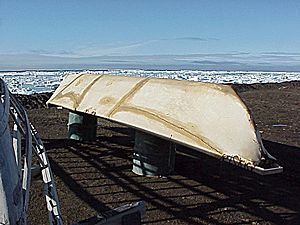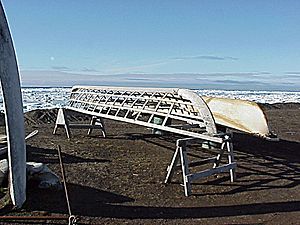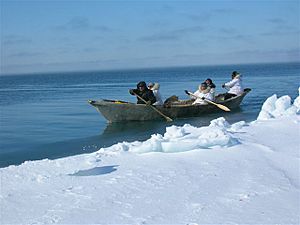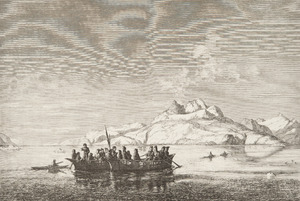Umiak facts for kids
The umiak is a special type of open boat. It is made from animal skins stretched over a frame. People like the Yupik and Inuit have used umiaks for a very long time. These boats were originally found in coastal areas from Siberia to Greenland.
Umiaks were first used by the ancient Thule people. They were traditionally used in summer. People used them to move their families and belongings. They also traveled to different hunting areas. Umiaks were important for hunting large animals like whales and walrus.
People usually moved the umiak with oars or paddles. Women often used oars, while men used paddles. Sometimes, sails made from seal parts were also used. In the 1900s, some umiaks even had outboard motors. An umiak does not have a keel, which is a part that helps a boat steer. This means sails cannot be used for zigzagging against the wind.
How Umiaks Are Built
Umiaks are built in a special way, similar to a kayak. The frame is made from driftwood or whalebone. These pieces are joined together using pegs and ropes. Sometimes, antlers or ivory were also used to connect parts.
Over this frame, people stretch the skins of walrus or bearded seals. To make the boat waterproof, oil (usually from seals) is put on the seams. A large umiak, about 30 feet (9 meters) long, needed about seven skins sewn together. These skins were stretched over the frame and left to dry. Today, umiaks are built almost the same way. The main difference is that metal bolts and screws are now used.
The umiak is much bigger than a kayak. Kayaks were built for one or two hunters. Umiaks are usually 30 to 33 feet (9 to 10 meters) long. They can be 5 to 6.5 feet (1.5 to 2 meters) wide. A missionary named Hans Egede saw umiaks that were 60 feet (18 meters) long in Greenland in 1721.
An umiak can carry up to 15 people. Even with many passengers, it is very light. It also does not have a keel. This makes it easy for a few people to carry it over drift or shore ice. They can then reach open water. A modern company that teaches how to make umiaks says a 24-foot (7.3-meter) boat weighs about 150 pounds (68 kg). This is much lighter than a modern boat of 750 pounds (340 kg).
Umiaks Today
In many parts of the Arctic, people no longer use umiaks and kayaks as much. However, in the Yupik and Inupiat whaling villages of Alaska, the umiak is still a very important part of life.
Whaling crews use snowmobiles to pull the umiak on a sled. They travel over rough trails cut through ice ridges. They go to places where there are open areas in the ice pack. There, they use the umiak to hunt whales.
The skin cover on an umiak usually lasts for two or three years. An aluminum boat used for whaling also lasts about the same time. But it is much easier to replace the skin on an umiak than to fix an aluminum boat. Also, bowhead whales are sensitive to the metallic noise from aluminum boats. They tend to swim away under the ice to avoid them.
In Utqiaġvik, Alaska, replacing an umiak's skin starts in July. This is when the ice moves away from the shores of the Arctic Ocean. Whaling crews hunt for oogruk, which are bearded seals, to get suitable skins. The skins are stored in seal oil and allowed to ferment until March. Then, the hair is scraped off the skins. They are sewn together with a special waterproof stitch. Finally, they are stretched over the wooden frame and tied into place using strong threads from caribou.
Once the new skin is on the frame, the umiak is left outside to dry in the wind and cold. In May, when bowhead whales swim east past Point Barrow, the umiak skin boats are pulled on sleds by snowmobiles out onto the ice.
Why It's Called an Umiak
The umiak is sometimes called a "woman's boat." However, modern Inuit dictionaries translate umiak simply as "boat," "traditional skin boat," or "any type of boat." Some examples include Kangiryuarmiut Uqauhingita Numiktittitdjutingit by Ronald Lowe, the Inuinnaqtun English Dictionary, and Asuilaak Inuktitut Living Dictionary.
In the Eastern Arctic, the umiak was not often used for hunting. It was mainly used in summer to transport women and children. Men usually traveled by kayak. Because of this, it became known as a "woman's boat" in that region.
See also
 In Spanish: Umiak para niños
In Spanish: Umiak para niños





